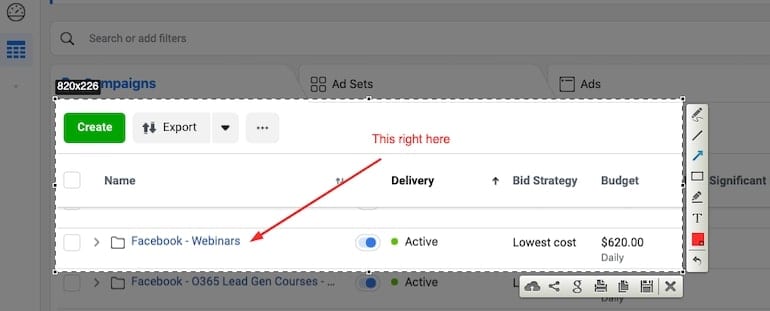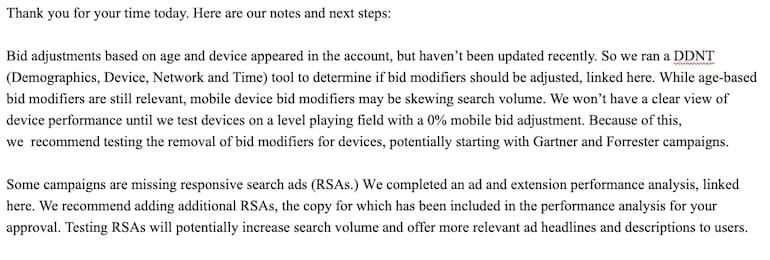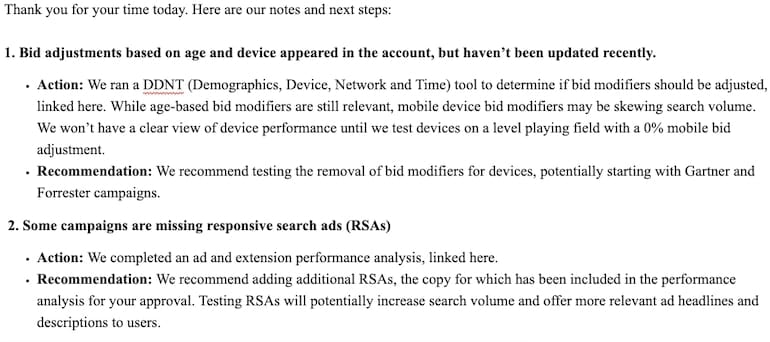The Writing Style Of Most Persuasive Messages Tends To Be
You sit down to write an important report or email to a client, boss, or co-worker. After much effort, you click "send". You've outlined your strategies with great detail. You've set expectations and made recommendations. Then, your reader comes back to you with the most disappointing response of all:
"Oh, that email? I didn't have a chance to read it."
You could blame your audience for being too impatient to read your tome. But as Dale Carnegie said, "Instead of condemning people, let's try to understand them." Your multi-paragraph argument on the value of automated bidding may be essential to you, but long emails and detailed reports can be daunting to read. Your audience thinks to themselves as their coffee cools, "Ok…I don't have time to read this." Whose fault is that? It's the writer's fault.
How can you improve your writing to make a message clearer? How can you reduce the reader's anxiety? Below are 5 tips on how to simplify your writing so you can easily persuade your audience and ensure your messages are read.
1. Recognize when you should NOT write
In the work-from-home world of COVID-19, you can't walk up to a co-worker's desk. But you can hit up a colleague or client on a Slack chat or video call, and screen share exactly what you mean instead of stumbling to write overly descriptive words.
When you sit down to write, set a timer. If your message takes longer than 3-5 minutes to write, consider using a different form of communication. Reach your audience in real-time instead, even if it's for a few minutes.
When in doubt, say it with a screenshot. One tool I find invaluable is the Lightshot extension, which allows you to annotate your screenshots like so:

2. Know your audience
All good writing starts with the audience in mind. Here are some things to consider before you sit down to write:
- What is their knowledge base?
- Will they understand marketing jargon?
- Are they "looped in" or do they need a history lesson?
- Do they concur with the KPIs & goals you've set?
- What are their expectations?
- Does your audience think you're credible, or do you need to gain their trust?
- How "deep in the weeds" do they want to go?
- What is their professional background?
- What are the stakes?
- Is there a boss to impress or a promotion they're chasing?
- What time commitment are you asking of them?
- Are they busy? How much time do they have to read your message?
- C-suite audiences tend to require more brevity than their grunt worker colleagues.
- Are they busy? How much time do they have to read your message?
Knowing all of these things about your audience will help you with the next step of writing simply, which is…
3. Outline your thoughts
It may seem tedious to plan your writing before setting pen to paper, but outlines will help you identify the most important points, and scrap the fluff.
- A classic technical writing outline technique is "Madman, Architect, Carpenter, Judge", first developed by Betty S. Flowers at University of Texas. This video outlines the process succinctly in less than 5 minutes.
- Another good way to outline is described in this article from Grammarly.
- Being detailed enough without clutter is important – this article covers some effective email technique that makes your writing easy to digest.
4. Use bullets wherever you can
The impact of bullets is clear. Would you rather read this email that is only a big block of text:

…or this email that outlines key actions taken and recommendations of next steps?

5. Simplify, then simplify some more
Business writing is full of unnecessary words and jargon. It's best to be simple and clear. A good way to check yourself is to use this handy checklist of 93 Ways to Simplify Your Writing from Writers Write. Weak phrases can be replaced by simple, impactful words. Using overly complicated words can harm your reputation by implying you are trying too hard to impress the reader, and it can be perceived as less professional.
Here is an example of overly complicated writing:
- We could provide a master list of objectionable college, course, and education keywords that we use across accounts at Hanapin/Brainlabs that we could utilize. That list is attached. We could implement it if you would like.
Here is a better version of the same message:
- Attached is a master list of negative keywords, targeting education queries. We recommend adding this list to all campaigns for an immediate lift in relevant search targeting.
And here is yet another, "best" version of the same message:
- Attached is our list of negative keywords to exclude education queries. With your approval, we will add this list to all campaigns. The additions will improve search relevance.
Other nuggets of wisdom for simplifying your writing:
- Use active tense when possible, to hold the attention of your reader.
- Example: Avoid "we'd like the testing to include" in favor of "the test will include"
- Instead of using weak words like "could", "might", "maybe", and "we think", use stronger language such as "we recommend", "will", and "with your approval" followed by the action your team plans to take.
- The Gmail plugin, Just Not Sorry warns you when you write emails using words which undermine your message
- Instead of using "After a period of time…" – replace with actual dates and always use ETAs, to remove any doubt of delivery time.
- Instead of using "A large percentage of…" – replace with actual percentages and data.
If you'd like to take your writing to the next level, here are some resources for more learning:
- Books:
- "The Elements of Style" by Strunk and White
- "About Writing: A Guide" by Robin Jeffery
- Quick reads:
- Essay: Politics and the English Language essay by George Orwell – PDF Link
- Blog post: Writing emails to influence a buyer's decision – Dale Carnegie style
The Writing Style Of Most Persuasive Messages Tends To Be
Source: https://www.ppchero.com/5-tips-for-marketers-write-simple-persuasive-messages-your-audience-will-actually-read/
Posted by: halpinhounch39.blogspot.com

0 Response to "The Writing Style Of Most Persuasive Messages Tends To Be"
Post a Comment